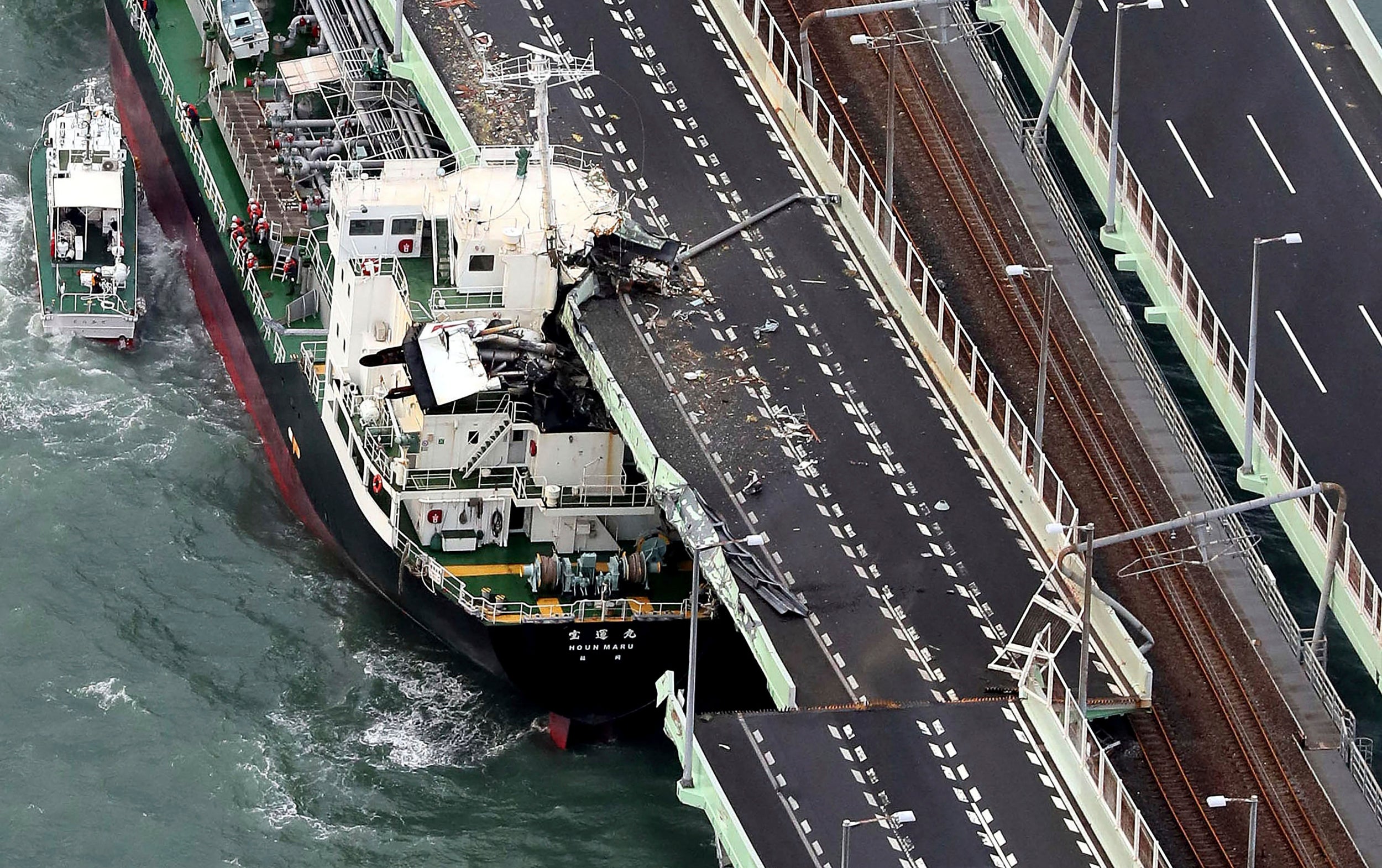Typhoon Jebi: Scenes of devastation in Japan as death toll rises to 11
Stranded passengers have started to leave flooded Kansai International Airport – but by boat, rather than by plane

Your support helps us to tell the story
From reproductive rights to climate change to Big Tech, The Independent is on the ground when the story is developing. Whether it's investigating the financials of Elon Musk's pro-Trump PAC or producing our latest documentary, 'The A Word', which shines a light on the American women fighting for reproductive rights, we know how important it is to parse out the facts from the messaging.
At such a critical moment in US history, we need reporters on the ground. Your donation allows us to keep sending journalists to speak to both sides of the story.
The Independent is trusted by Americans across the entire political spectrum. And unlike many other quality news outlets, we choose not to lock Americans out of our reporting and analysis with paywalls. We believe quality journalism should be available to everyone, paid for by those who can afford it.
Your support makes all the difference.Japan’s government said at least 11 people are confirmed dead and more than a million homes remained without power on Wednesday, as the country counted the cost of the most powerful storm to hit the mainland in 25 years.
Typhoon Jebi peeled roofs off buildings, flipped vehicles, toppled power poles and sent a 2,700 ton tanker crashing into the side of a bridge.
The operator of flooded Kansai International Airport, where around 3,000 tourists were stranded while the storm crossed over Japan, began transferring passengers by high-speed boat and bus to nearby Kobe port.
One passenger was slightly injured by shards from a window shattered by the storm, and others said they were exhausted but relieved that the worst had passed.
Jebi has now been downgraded to a tropical storm, and is heading north of Japan. At its peak it was briefly a super typhoon, meaning wind speeds exceeded 150mph.
The tanker that was in the process of mooring had slammed into the side of a bridge connecting the airport to the mainland, damaging the bridge and rendering one of the two roads over it unusable, transport ministry official Mitsuo Nakao said.
The tanker was also damaged, but all its 11 crewmembers were not injured and rescued safely, according to the coast guard. The heavily damaged ship has been pulled away from the bridge into nearby open waters.

The deaths included a man in his seventies who was blown to the ground from his apartment in Osaka prefecture. Police said five others died elsewhere in the prefecture after being hit by flying objects or falling from their apartments.
In nearby Shiga prefecture, a 71-year-old man died when a storage building collapsed on him, and a man in his seventies died after falling from a roof in Mie, officials said.
Daihatsu Motor Co stopped production at its Kyoto and Osaka factories, while Panasonic halted work at its air conditioning and refrigerator factory in Shiga. Major beverage maker Kirin Co suspended production at its brewery in Kobe, according to the Kyodo News agency.
In nearby Nishinomiya in Hyogo prefecture, about 100 cars at a seaside dealership burned after their electrical systems were shorted out by seawater, fire officials and news reports said.
Among the many buildings damaged by the storm was a world heritage site, the Nishi Honganji temple in the ancient capital Kyoto. According to national broadcaster NHK, the typhoon damaged a traditional theatre roof and other structures considered to be important cultural assets in the country.
In Osaka, the Universal Studios Japan theme park remained closed for a second straight day, though a news release said it would open again on Thursday.
Videos posted to social media during the storm showed the Tempozan Ferris Wheel, an Osaka landmark which was also closed, nonetheless spinning at high speed as it was caught in the wind.
Chief cabinet secretary Yoshihide Suga said in a news conference on Wednesday morning that about 300 people had been injured, a number which was doubled to 600 by officials later in the day. “The government will continue to do everything possible to tackle these issues with utmost urgency,” Suga told a news conference.
It could take several days to a week to reopen Kansai airport depending on the damage, the Yomiuri newspaper quoted an unidentified person in the airline industry as saying.
The airport served 28 million passengers last year, and that number is expected to grow as Japan opens up to tourism in recent years to keep its economy going. It serves Osaka, Kobe and Kyoto, all popular destinations for tourists.
Prime minister Shinzo Abe, criticised for an initially slow response to devastating floods in July, posted repeated updates on the rescue efforts at Kansai.
It is the latest in a string of extreme weather events to befall Japan, after a scorching heatwave and then torrential rains and flooding that killed more than 200 people in July. Jebi’s course brought it close to those flood-affected parts of western Japan, but most of the damage this time appeared to be from the wind.
Join our commenting forum
Join thought-provoking conversations, follow other Independent readers and see their replies
Comments